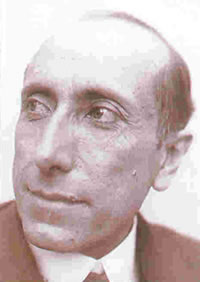Amado Nervo
| Amado Nervo | |
|---|---|
 |
|
| Born | Juan Crisóstomo Ruiz de Nervo August 27, 1870 Tepic, Nayarit, Mexico |
| Died | May 24, 1919 (aged 48) Montevideo, Uruguay |
| Resting place | Rotunda of Illustrious People in Mexico City, Mexico |
| Occupation | Poet, journalist, educator, Mexican Ambassador to Argentina and Uruguay |
| Language | Spanish |
| Nationality | México |
| Period | 19th and 20th centuries |
| Genre | fiction, poetry, essay |
| Literary movement | Modernism |
| Spouse | Ana Cecilia Luisa Dailliez (1901–1912) |
Amado Nervo (August 27, 1870 – May 24, 1919) also known as Juan Crisóstomo Ruiz de Nervo, was a Mexican poet, journalist and educator. He also acted as Mexican Ambassador to Argentina and Uruguay. His poetry was known for its use of metaphor and reference to mysticism, presenting both love and religion, as well as Christianity and Hinduism. Nervo is noted as one of the most important Mexican poets of the 19th century.
Amado Nervo was born in Tepic, Nayarit (1870). His father died when Nervo was 9 years old. Two more deaths were to mark his life: the suicide of his brother Luis, who was also a poet, and the death of his wife Ana Cecilia Luisa Daillez, just 11 years after marriage.
His early studies were at the Colegio San Luis Gonzaga, located in Jacona, Michoacán. After graduation, he began studying at the Roman Catholic Seminary in nearby Zamora. His studies at the seminary included science, philosophy and the first year of law. It was here, that Nervo cultivated an interest in mystical theories, which were reflected in some of his early works.
While Nervo had early plans to join the priesthood, economic hardship led him to accept a desk job in Tepic. He later moved to Mazatlán, where he alternately worked in the office of a lawyer and as a journalist for El Correo de la Tarde (The Evening Mail). He went on to become a successful poet, journalist, and international diplomat.
In 1894, he continued his career in Mexico City, where he became known and appreciated, working in the magazine Azul, with Manuel Gutiérrez Nájera. It was during this time that he was introduced to the work of Luis G. Urbina, Tablada, Dávalos, Rubén Darío, José Santos Chocano, and Campoamor. His background in journalism and news reporting flourished during these years, as he continued writing for El Universal, El Nacional, and El Mundo. He maintained a formal partnership with El Mundo through June 1897.
In October 1897, El Mundo launched a supplement called La Comedia del Mundo, with Nervo taking responsibility for the overall production. In January 1898, the supplement was established independently from El Mundo and changed its name to La Comedia.
...
Wikipedia
